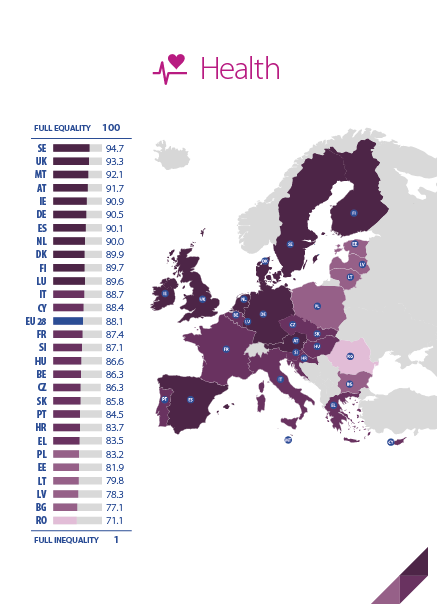7. Domain of health
Gender is understood as one of a wide range of factors that shape the health outcomes of a population (Sen, Östlin, & George, 2007), especially in relation to life expectancy, exposure to risk factors and mental health issues (OECD/EU, 2018). These factors include the physical, social and economic environment, as well as a person’s individual characteristics and behaviour, and can be described as ‘circumstances in which people are born, grow up, live, work and age and the systems put in place to deal with illness’ (Stronks, Toebes, Hendriks, Ikram, & Venkatapuram, 2016, p. 5).
Some of those factors promote health, such as a higher education level or access to clean water and safe housing, while others can damage it, such as stereotypical gender norms, experiences of gender-based violence or lack of access to and utilisation of medical services.
Gender relations and the unequal division of power associated with them are considered to be the most important social determinants of health (Sen, Östlin, & George, 2007) because they permeate every aspect of an individual’s life from infancy to old age, and as such influence their ability to access resources, to make decisions and to care for their health.
Timely access to good-quality, affordable healthcare (both preventive and curative) plays a critical role too. It has been affirmed as a right and is included in the 20 principles of the European Pillar of Social Rights. This inclusion, along with the right to gender equality, access to LTC services, and a healthy work environment and social protection, underlines that beyond biological factors, health is the outcome of several determinants which require an interconnected, multidisciplinary approach.
Improving health and reducing inequalities across and within Member States are among the strategic objectives of both the EU third health programme (2014-2020) (European Commission, 2014) and Health 2020, the WHO-led regional health strategy for Europe adopted in 2012 (WHO, 2013). The importance of achieving universal health is also enshrined in the sustainable development goals with Goal 3 focused on health and well-being and the Goal 5 gender-equality targets also encompassing health issues affecting women.

The domain of health measures three health-related aspects of gender equality: health status, health behaviour and access to health services. Health status looks at the gender differences in life expectancy, together with self-perceived health and healthy life years (also called disability-free life expectancy).
This is complemented by a set of health behavioural factors based on WHO recommendations, namely fruit and vegetable consumption, physical activity, smoking and alcohol consumption. Access to health services is measured by the percentage of people who report unmet medical and/or dental needs.
Women in the EU live longer than men, however they spend longer time in ill health. Considering that the ageing population is becoming feminised, social care and healthcare need to take into account a gender-sensitive perspective to address this issue. Moreover, life expectancy, well-being and access to healthcare are determined by further factors, such as level of qualifications, socioeconomic status, family type, ethnicity or sexual and gender identity, calling for a closer look at inequalities among different groups of women and men.
